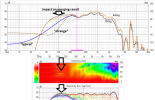Sorry brain fart!

I started last night writing about the minimal port area thinking, it's DIY, so people are free to adjust the dimensions…
Then this morning reading the comments about the difficulties to get the job done I though I should try to find something with a minimal amount of modifications.
I got distracted...
Still, the idea is to add one panel on the back

not necessarily just 18mm, 22mm (or more) works too,
Then relocating the ports might work even if it means cutting a bit of the plastic flange.
This the front view but the ports are at the back, the two circles are 45mm in diameter
They would need to move towards the center line of the speaker by a small amount in real life.
The length is OK with the added thickness, by hollowing out a good portion of the existing back panel the volume stays about the same.
Someone would have to double check though as I have been known to make mistakes.
View attachment 367348
Anyways, I’d rather redo the box to have a better port and LF performance.


